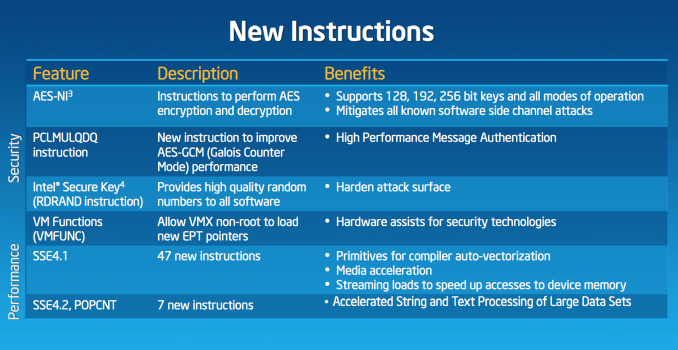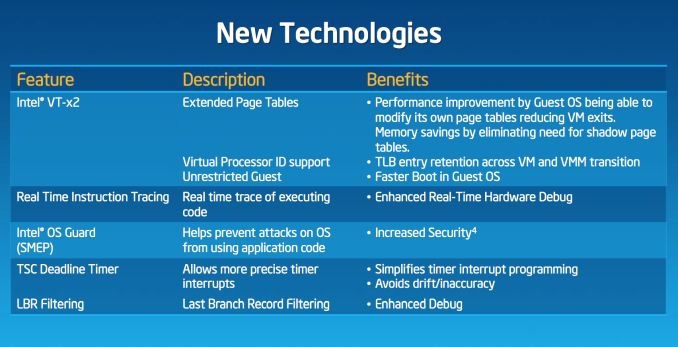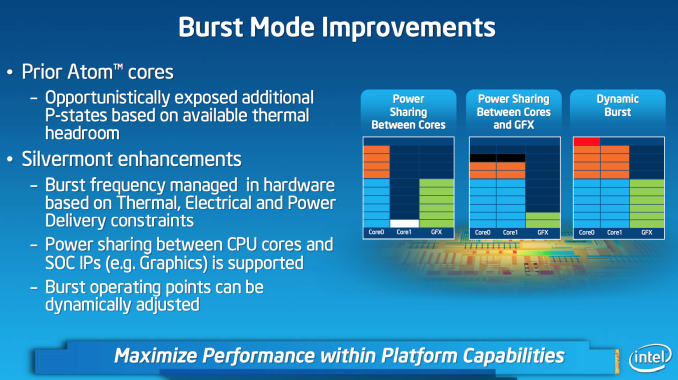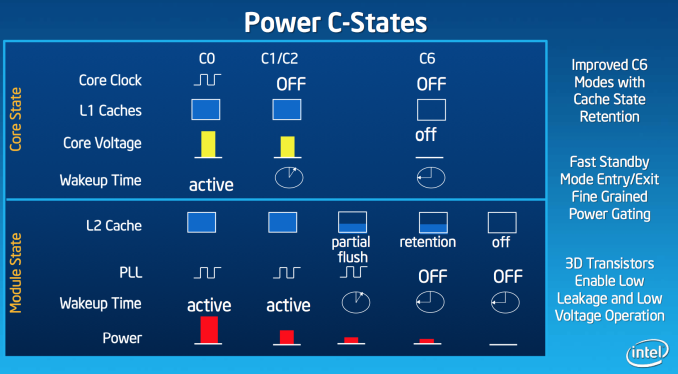Intel’s Silvermont Architecture Revealed: Getting Serious About Mobile
by Anand Lal Shimpi on May 6, 2013 1:00 PM EST- Posted in
- CPUs
- Intel
- Silvermont
- SoCs
ISA
The original Atom processor enabled support for Merom/Conroe-class x86 instructions, it lacked SSE4 support due to die/power constraints; that was at 45nm, at 22nm there’s room for improvement. Silvermont brings ISA compatibility up to Westmere levels (Intel’s 2010 Core microprocessor architecture). There’s now support for SSE4.1, SSE4.2, POPCNT and AES-NI.
Silvermont is 64-bit capable, although it is up to Intel to enable 64-bit support on various SKUs similar to what we’ve seen with Atom thus far.
IPC and Frequency
The combination of everything Intel is doing on the IPC front give it, according to Intel, roughly the same single threaded performance as ARM’s Cortex A15. We’ve already established that the Cortex A15 is quite good, but here’s where Silvermont has a chance to pull ahead. We already established that Intel’s 22nm process can give it anywhere from a 18 - 37% performance uplift at the same power consumption. IPC scaling gives Silvermont stable footing, but the ability to run at considerably higher frequencies without drawing more power is what puts it over the top.
Intel isn’t talking about frequencies at this point, but I’ve heard numbers around 2 - 2.4GHz thrown around a lot. Compared to the 1.6 - 2GHz range we currently have with Bonnell based silicon, you can see how the performance story gets serious quickly. Intel is talking about a 50% improvement in IPC at the core, combine that with a 30% improvement in frequency without any power impact and you’re now at 83% better performance potentially with no power penalty. There are other advantages at the SoC level that once factored in drive things even further.
Real Turbo Modes & Power Management
Previous Atom based mobile SoCs had a very crude version of Intel’s Turbo Boost. The CPU would expose all of its available P-states to the OS and as it became thermally limited, Intel would clamp the max P-state it would expose to the OS. Everything was OS-driven and previous designs weren’t able to capitalize on unused thermal budget elsewhere in the SoC to drive up frequency in active parts of chip. This lack of flexibility even impacted the SoC at the CPU core level. When running a single threaded app, Medfield/Clover Trail/et al couldn’t take thermal budget freed up by the idle core and use it to drive the frequency of the active core. Previous Atom implementations were basically somewhere in the pre-Nehalem era of thermal/boost management. From what I’ve seen, this is also how a lot of the present day ARM architectures work as well. At best, they vary what operating states they expose to the OS and clamp max frequency depending on thermals. To the best of my knowledge, none of the SoC vendors today actively implement modern big-core-Intel-like frequency management. Silvermont fixes this.
Silvermont, like Nehalem and the architectures that followed, gets its own power control unit that monitors thermals and handles dynamic allocation of power budget to various blocks within the SoC. If I understand this correctly, Silvermont should expose a maximum base frequency to the OS but depending on instruction mix and available TDP it can turbo up beyond that maximum frequency as long as it doesn’t exceed TDP. Like Sandy Bridge, Silvermont will even be able to exceed TDP for a short period of time if the package temperature is low enough to allow it. Finally, Silvermont’s turbo can also work across IP blocks: power budget allocated to the GPU can be transferred to the CPU cores (and vice versa).
By big-core standards (especially compared to Haswell), Silvermont’s turbo isn’t all that impressive but compared to how things are currently handled in the mobile space this should be a huge step forward.
On the power management side, getting in and out of C6 should be a bit quicker. There's also a new C6 mode with cache state retention.















174 Comments
View All Comments
Jumangi - Monday, May 6, 2013 - link
Let me know when Intel has something of actual substance to show and not just bunch of marketing/hype focused Powerpoint slides. ARM continues to delivers solid performance gains year after year with low power usage...Intel says yea we'll will get around to updating our 5 year old design...eventually we promise...yawn...Krysto - Monday, May 6, 2013 - link
Great point. Intel keeps promising how awesome they will be when they launch their new "mobile" chip, and at always it's ALWAYS disappointing, because in the mean time ARM chips keep shipping on their merry way, and keep improving. Fast.A5 - Monday, May 6, 2013 - link
Eh. A15 wasn't exactly a home run. The performance is good for what it is, but they overshot their TDP targets big time.saurabhr8here - Monday, May 6, 2013 - link
A15 wasn't a home run because it has been developed on an early bleeding edge technology. As the process technology matures and the design is optimized for the process, the power/performance numbers will improve.DanNeely - Tuesday, May 7, 2013 - link
A15's problem isn't overshooting TDP targets; it's that it was originally designed for use in entry level NASes and other similar level embedded systems/micro servers. A few extra watts for better CPU performance isn't a big problem there.xTRICKYxx - Tuesday, May 7, 2013 - link
Exactly. A15 was not initially designed for smartphones.Wilco1 - Tuesday, May 7, 2013 - link
That's not correct, ARM has said from the early announcements that it would go into mobiles at lower frequencies and core counts. Of course both core counts and frequencies turned out to be higher than originally expected, so power consumption is higher too. The Exynos 5250 appears to be released quickly in order to be first to market. The Octa core is far more tuned and will do better. NVidia has stated Tegra 4 uses 40% less power than Tegra 3 at equivalent performance levels.Krysto - Monday, May 6, 2013 - link
Let's do a recap. Performance is as high as Cortex A15...a chip launched in 2012.GPU performance is where iPad 4 was...in 2012.
They are doing their benchmarks against last-gen ARM chips...okay.
Intel Silvermont is expected late 2013/early 2014.
Yeah...it's obviously so competitive! NOT.
By the time Intel Silvermont arrives in smartphones (Merrifield), we will see 20nm ARMv8 chips in smartphones, already shipping. Good luck, Intel, another hit and a miss.
As for what you said that Silvermont is conservative because they don't want to basically cannibalize Haswell - that's EXACTLY Intel's biggest problem right now. Their conflict of interest between the low-end, unprofitable Atom division, with the high-end very profitable Core division.
This is exactly what killed their Xscale division, too. And it's what will kill Intel in the end. Because Intel will have to make Atom compete *whether they want to or not*. ARM chips are going to go higher and higher performance and become "good enough" for most everything. What is Intel going to do then? They'll have to keep up, which will slowly eliminate their *profitable* Core chips from the market. And what then? Survive on $20 chips with a dozen competitors? This is going to be very interesting for Intel in the next few years - and not in a good way, especially with a brand new CEO.
Kjella - Monday, May 6, 2013 - link
It's been four months of 2013, how many quad-core ARM processors have launched since 2012? They're comparing against what is out now (if they were able to compare against unreleased ARM processors there'd be something very wrong) and beating them, not sure where your reading comprehension failed there. Looks to me like they're ready for a clash of the titans around year's end. Also 1-5W chips don't compete much with 15-85W Haswells no matter what, AMD is dying fast and people need their x86 computers so whatever. Reminds me of all the posts that say Windows is sooooooo dead.xTRICKYxx - Tuesday, May 7, 2013 - link
AMD is making a lot of money right now.